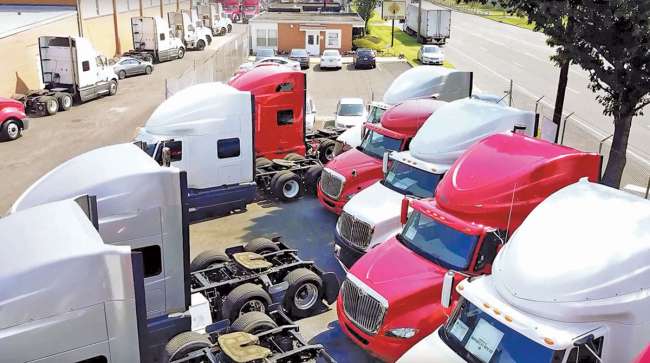Senior Reporter
February Used Class 8 Prices Set Records

[Stay on top of transportation news: Get TTNews in your inbox.]
February’s average retail sales price for a used Class 8 set another all-time record, besting January’s previous high by jumping beyond $94,000 — and sales may have hit their high point, according to ACT Research.
“In the very small amount of data we have seen so far for sales in March, it looks like February could have been the peak and we’ll start to see a sequential downturn,” ACT Vice President Steve Tam told Transport Topics in reference to his group’s data for the month. “It’s too early to call that, but it’s certainly a valid observation.”
ACT estimated used Class 8 sales in February were 21,900 compared with 20,700 a year earlier. In January, sales were 22,300.
Average US used truck prices were 7% higher compared to January, and 83% more expensive than in February of 2021, while average miles and age were flat sequentially, with miles up 3% y/y and age 5% higher than last February.https://t.co/ZHvt6oLet3#UsedTrucks, #Trucking pic.twitter.com/C1pyu3Ocvi — ACT Research (@actresearch) March 30, 2022
He called February’s average retail price “incredible” at $94,273 compared with $51,494 a year earlier. January’s price was $88,386, according to ACT, citing its own market estimates.
The price for a 3-year-old Class 8, based on data from all of ACT’s sources, rose to $152,828, also a new all-time record.
An 8-year-old Class 8 brought an average price of $44,181. A year earlier, that average price was under $20,000, said Tam.
Each month, ACT surveys a sample of dealers, wholesalers and auctioneers as well as a few large fleets to determine average price, age and mileage, and estimated industry volumes.
Tam said when demand starts to soften in the used truck market, customers for the oldest, highest mileage equipment “are the first ones to disappear.”
“You don’t see it in the February data yet; but I think that’s what’s happening” in March, he said. Tam suggested that the March data may show that people were paying for a 7-year-old truck what they were paying for an 8-year old truck a month earlier. “That dovetails with spot rates rolling over, but at the top line that’s being masked a little bit by the rising fuel prices,” he said.
FMIC-Cowen freight indexes recently reported spot rates, sequentially, decreased 130 basis points for dry van, decreased by 220 basis points for reefer, and decreased by 80 basis points for intermodal.
Dry van contract rates and temperature-control contract rates decreased sequentially in the week of March 28 while intermodal contract rates ticked up sequentially, according to the report.
The average used Class 8 sold retail in February was older and had higher mileage compared with the 2021 period — clear evidence of the delay in cycling trucks through the market and forcing owners to keep them longer than typical.
One key reason is new Class 8 sales — which typically generate trade-ins — have stalled since the beginning of the year and remained in a narrow band throughout much of 2021.

Smith
U.S. Class 8 retail sales in February fell compared with a year earlier, and landed just below 15,000 to put most truck brands in negative territory, Wards Intelligence reported.
One analyst saw in those latest sales numbers — which mimicked January’s total — another aspect of the disrupted supply chain. “This market is as frozen as you can get it,” said Don Ake, vice president of commercial vehicles at FTR.
The average mileage on a used Class 8 in February was 439,000 compared with 427,000 a year earlier. The age of the average Class 8 sold was 6 years, 7 months. That compared with 6 years, 3 months a year earlier.
One finance company executive said he has seen an increase in repair and operating capital loans.
“Small fleets are investing in their current inventory to keep them on the road for significantly longer than normal,” Charles Smith, regional business development manager at Mission Financial Services Group Corp., an Atlanta-based lender, told TT. He maintained dealers across the country continue to have issues finding and keeping up with used inventory to sell.
As for the recent rise in interest rates, “historically they have had a negative impact on truck demand as cost to finance the equipment goes up. Fuel expenses will end up having the biggest impact on truck companies and the individual owner-operator,” Smith said.
U.S. average on-highway #diesel fuel price on March 28, 2022 was $5.185/gal, UP 5.1¢/gallon from 3/21/22, UP $2.024/gallon from year ago https://t.co/uEBq8uMFZ1 #truckers #shippers #fuelprices pic.twitter.com/NAUiqbW4hT — EIA (@EIAgov) March 29, 2022
The national average price for diesel resumed its upward trajectory after a one-week respite, gaining 5.1 cents to settle at $5.185 a gallon, according to Energy Information Administration data released March 28.
Diesel has gained in 11 of the past 12 weeks, the exception being an 11.6-cent decline March 21. A gallon of trucking’s main fuel now costs $2.024 more than it did at this time in 2021.
“Unfortunately, there is no crystal ball to tell us when prices of used trucks and fuel will come down,” Smith said. “Trucks are hitting the used market with 700,000 to 1 million miles on them, and prices continue to be high on those.”
Want more news? Listen to today's daily briefing below or go here for more info:




